Siphons for an aquarium: choosing a vacuum cleaner for cleaning the soil
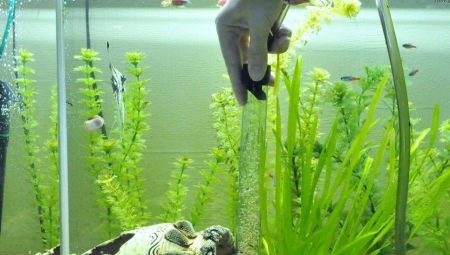
Silt, food, waste products of fish - all this remains in the aquarium and sinks to its bottom. This place turns out to be the dirtiest and requires periodic cleaning. For this there is a special device that works on the principle of a vacuum cleaner, pumping out dirt from the depths.
Appointment
The aquarium siphon is a pump with rarefied air that comes out of a special pipe. Thanks to the device, water and liquid waste can be pumped from the depths. The device with a hose is installed close to the bottom; there is a filter inside which retains dirt. Clean water flows back into the aquarium; there is a flexible tube for this. It is lowered below the level of the bottom in the case of a mechanical device.
Electrical models do not imply rules for the placement of the outlet pipe. In the latter version, its size is important - the larger it is, the faster the soil will be cleaned. In the first embodiment, the low end of the hose has an effect on traction. It will be larger than the tube below. The soil siphon works by sucking in sludge, food debris and other debris. Thus, the bottom is cleared.
It is very important to monitor his condition. This procedure is necessary for aquariums of any size, including the smallest.
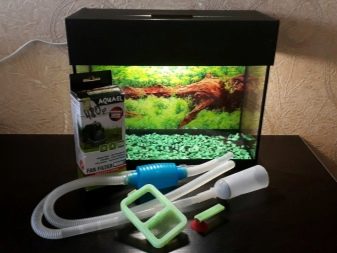

The siphon is also often used to replace part of the water in an aquarium. It is recommended to update it on a weekly basis, otherwise the optimal conditions of detention will be lost. To improve the quality of life of the inhabitants, it is enough to replace about a quarter of the total volume.
Water renewal is usually combined with soil cleaning. The principle of operation involves the use of special attachments, which are similar to those of an ordinary household vacuum cleaner. A device for cleaning the bottom and water in the aquarium is available for do-it-yourself production. There are modern improved models on sale.

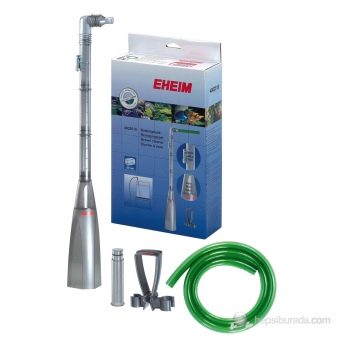
Varieties
An aquarium is an artificial system that needs to be kept in balance at all times. Without proper care, unfavorable conditions arise that lead to the death of the inhabitants. Aquarium cleaners come in two main types: electrical and mechanical.
Electrical
This species can be used in both freshwater and saltwater aquariums. They are especially useful in aquariums with abundant vegetation. Electrical equipment is characterized by high power. Another characteristic of the devices is their extensive suction power. The device will quickly collect all debris from the bottom, including from hard-to-reach places.
The suction of small fish and fry is excluded with a device with a special filter. If you follow the instructions, then the performance of the electrosiphon will be maintained for a long time. Installation is possible at any point in the aquarium, even a beginner will not have any questions with this question.
An electric siphon with a pump is safe to use, since all parts are reliably insulated. Water resistance is ensured by durable plastic with shockproof qualities.
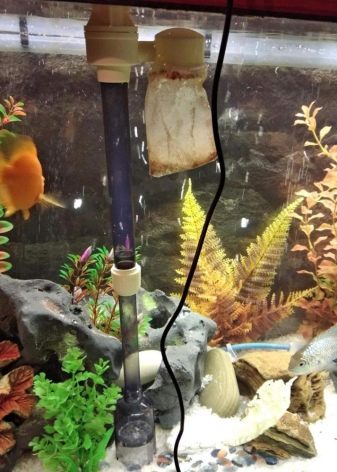
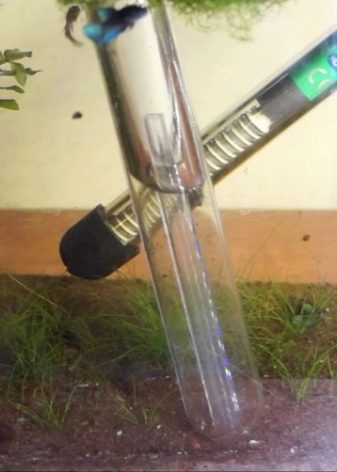
The operation of a vacuum cleaner for cleaning is impossible without a special pump. With its help, water is drawn in, which, passing through the filters, is cleared of dirt. Some models have special cartridges installed inside. They are distinguished by inclined planes that attract dirt. The system effectively filters the aquarium water. Over time, the cartridges are washed out or replaced with new ones. The flow of water in a clogged appliance becomes weaker and efficiency decreases.
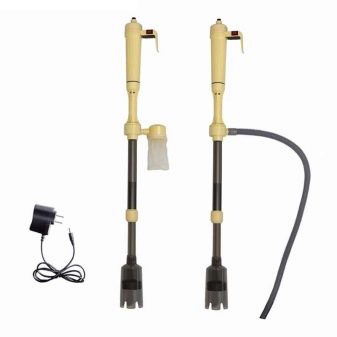
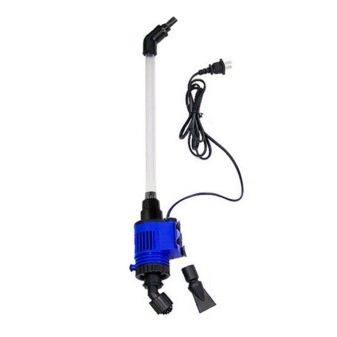
Mechanical
great depth. In containers half a meter deep, water can be poured This type differs from the previous one in a more primitive design. The manual version is good for beginners who are just trying their hand at the aquarium business. The models are simple, but require additional devices that can be used to clean the glass. In a mechanical product, a regular rubber bulb is needed to pump water. It is additionally equipped with a funnel or a conventional cylindrical plastic body.
It is very convenient when this part is transparent. You can immediately see the small inhabitants and exclude their death. A container of some kind is needed to drain the water from the mechanical siphon. For her, you need to find a hose of the optimal length. To get started, just squeeze and unclench the rubber bulb. This will take some effort and dexterity.
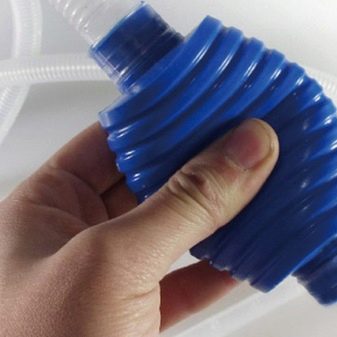
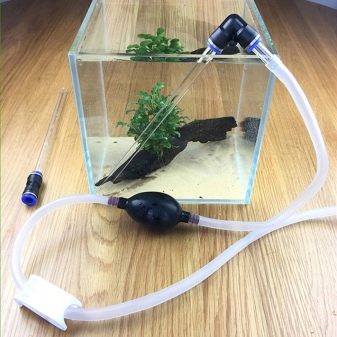
An alternative version of the siphon can be a battery-powered device. It does not provide for draining the water, which already makes the task easier. No hose required for operation. An important feature is the regulation of the flow and the presence of a special compartment called a trap.
A significant disadvantage of the model is that the cleaner is suitable only for a small aquarium of shallow depth. In containers of half a meter depth, water can fill the batteries, the device will be inoperative.
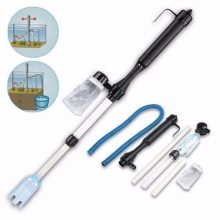
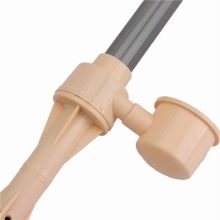
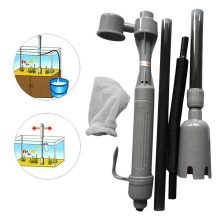
Which one is better to choose?
The soil cleaner is able to accurately cope with cleaning without disturbing the biological balance established in the artificial aqua system. Aquariums of various capacities need cleaning. Due to the variety of vessels, it is important to correctly navigate the parameters of the device. Another thing to consider is the number of living beings. Ease of use is also important.
For example, the diameter of the hose must be smaller than the size of the pebbles on the bottom... The transparent product will help you easily control the cleaning. It will be lightweight and comfortable with plastic hoses.
If the aquarium is small and has small inhabitants, it is better to pay attention to low-powered small models.A more massive device can be chosen for a voluminous dwelling of fish. A weak ground cleaner will not cope with a hefty amount of work.

The diameter of the hose is of great importance, since with a strong flow, all the soil may not be cleared, and the water will merge into the container. The inhabitants of the nanoaquarium may be left without a habitat. You can also pay attention to the nozzles of aquarium siphons, they come in different sizes. For example, large ones are convenient for cleaning the middle of the aquarium. Small triangular elements are ideal for cleaning corners and small decorative details.
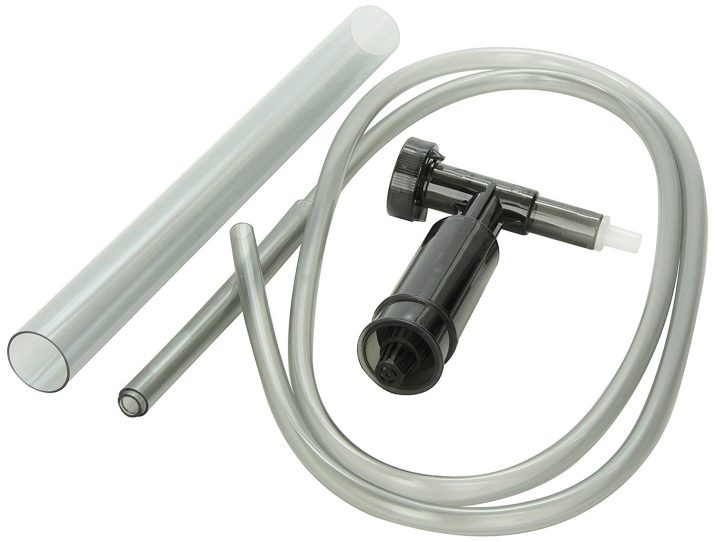
Mechanical and electrical hose models are available from various companies. The products of these companies are of high quality, there are many models, each has many positive qualities.
We present the rating of the most popular companies:
- Aquael;
- Tetra;
- JBL;
- Sera.
For example, siphons Aquael characterized by their versatility, they are able to clean both the soil and the glass of the aquarium. The main component of the classic Polish-made siphon is a transparent plastic case. An additional component is a rigid hose. A special mesh is provided to protect the container from foreign objects. The cost of products is affordable: from 500 to 1000 rubles (2019).
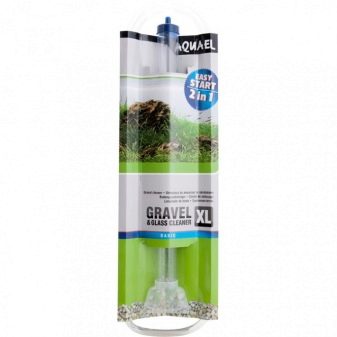
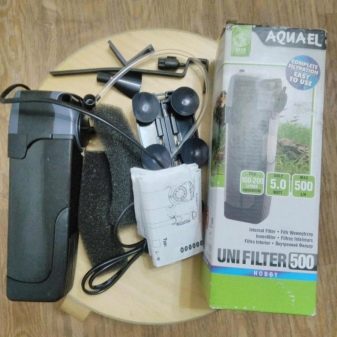
Tetra company offers a large assortment of products that are distinguished by great power. An additional valve is responsible for this parameter, which can be adjusted. The devices also have other devices that facilitate the task of cleaning the soil. The price of products is related to the type of models and varies from 200 to 900 rubles (2019).
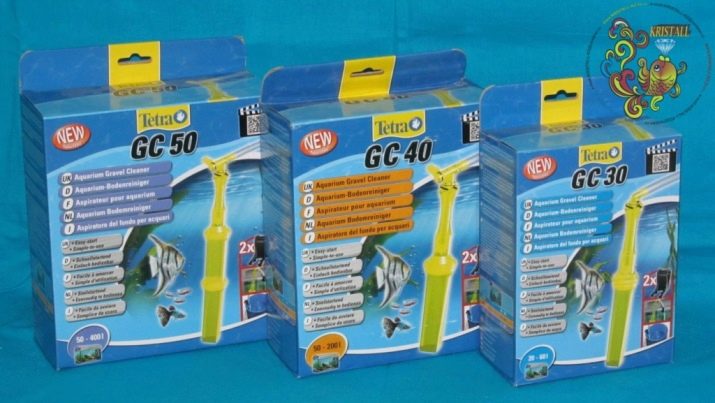
JBL - a manufacturer from Germany, engaged in the production of products for garden ponds, terrariums and aquariums. German siphons are distinguished by numerous options. Due to the additions, the price of the products is rather big, but the products are considered to be of very high quality.
Slightly cheaper German siphons by Sera, which has been known on the market for more than a dozen years. The plastic of the products is very high quality, transparent, non-toxic for fish. A special supplement eliminates the absorption of plants and fry. Different siphons differ in design, and, accordingly, in the rules of operation.
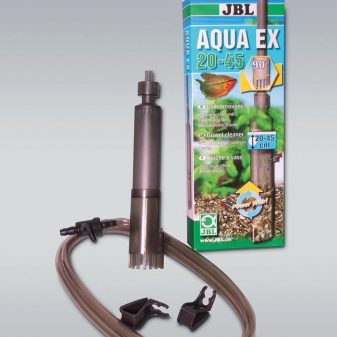
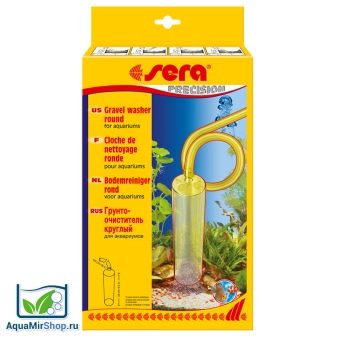
How to clean the aquarium soil?
Bottom cleaning is a hassle task even with additional tools. It can be kept clean by throwing the feed in small handfuls or by effectively using special pellets that are attached to the sides of the container. According to the instructions, first cleaning the walls of the aquarium is recommended. It is possible without changing the water - you just need to wait for all the dirt to fall to the bottom. The procedure takes approximately 20 minutes.
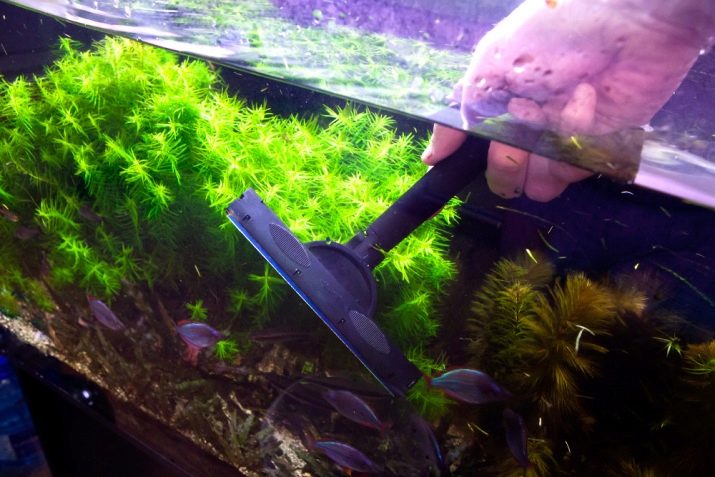
If a mechanical siphon is used, then you need to drive along the bottom with a hose during the entire cleaning process, and work with a pear constantly. If the design does not provide for the drain of all the dirt into the bucket, then this should be done after about 30 taps on the pear. Before each new entry, it is advisable to turn over all the stones at the same time. This will serve not only as an excellent prevention, but also helps to improve the appearance. The desired interval of the procedure is once every 2 weeks. After cleaning, the growth of algae is accelerated.
If the siphon includes filtration elements, they must be rinsed regularly, as harmful organisms accumulate inside. Do not use soap solutions or hot water to clean the filters. Also, you cannot sterilize the mechanisms with alcohol-containing agents.
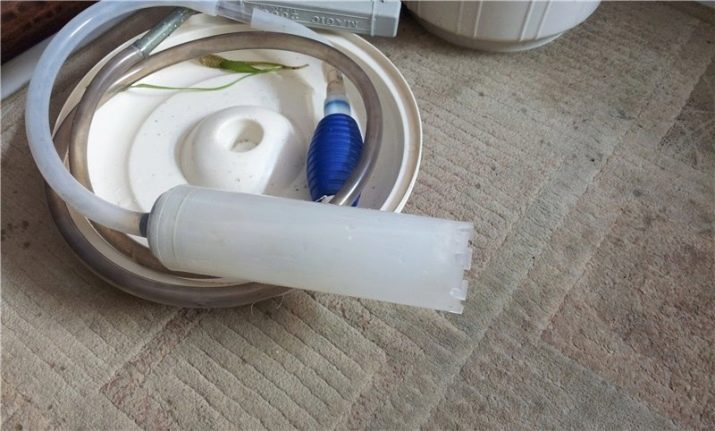
Useful Tips
A signal for cleaning can be a smell from the aquarium, which resembles a rotten egg or rotten hay. This indicates the presence of poisonous gas, which appeared due to the waste product of fish. Because of it, the amount of oxygen decreases, and this affects the health of the inhabitants.
Before harvesting, it is advisable to transplant the fish into another container. The dirty water from the aquarium is poured out by half, the stones can be removed for further rinsing.For this procedure, you can use ordinary running water, but it is advisable to add sea salt. The component needs about 50 g per liter of water. Additional minerals can be used for cleaning. For example, coral is often used not only as a decoration, but also as a kind of natural filter.
Using a siphon, you can replace part of the water in the aquarium without harming the fish. Once a week, you can change about 10% of the total. At an interval of a month, you need to change about 25% of the liquid.
If the procedure is performed less frequently, then about 70% of the water needs to be changed.
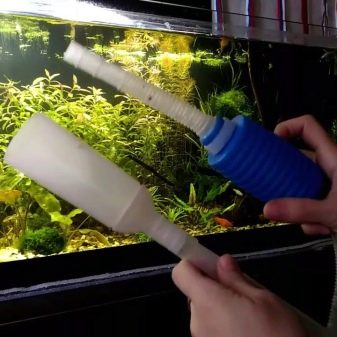
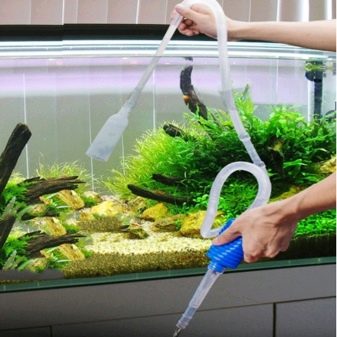
You can add tap water, but it should sit for about a day. Specialists add special substances, one of which is sodium thiosulfate 30%. Many people often use fish that clean the aquarium. Such natural orderlies have different effectiveness, but they are no less beautiful in appearance, for example:
- catfish;
- mollies;
- Girinoheil Siamese;
- pterygoplichta;
- labeo;
- ototsinklus.
Every aquarist is aware of the need to maintain an interspecies balance. Caring for an aquarium requires:
- daily inspection;
- checks of temperature and main systems.
The yellowness of the plants can indicate the need to replace water and clean the soil. It can also be a sign of an overabundance of chemicals in the water.
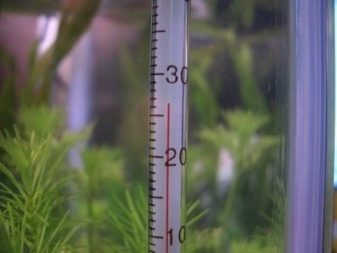

How the siphon works, see below.








